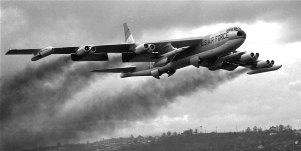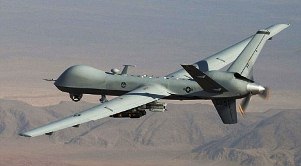And harbour no illusions regarding a President that now specifically targets civilians with a kill list. From the criminal terrorist carpet bombing of Indo-China to the 1.5 million plus civilians killed in Iraq, American war crimes continue because other nations and superpowers allow it. If your government is ally or party to US crimes against humanity perhaps some thought and appropriate action at your next government elections. The LAW is only as effective as the people's sense or morality.

B-52's rained death over Indo-China
Pham To looked great for 78 years old. (At least, that’s about how old he thought he was.) His hair was thin, gray, and receding at the temples, but his eyes were lively and his physique robust -- all the more remarkable given what he had lived through. I listened intently, as I had so many times before to so many similar stories, but it was still beyond my ability to comprehend. It’s probably beyond yours, too.
Pham To told me that the planes began their bombing runs in 1965 and that periodic artillery shelling started about the same time. Nobody will ever know just how many civilians were killed in the years after that. “The number is uncountable,” he said one spring day a few years ago in a village in the mountains of rural central Vietnam. “So many people died.”
And it only got worse. Chemical defoliants came next, ravaging the land. Helicopter machine gunners began firing on locals. By 1969, bombing and shelling were day-and-night occurrences. Many villagers fled. Some headed further into the mountains, trading the terror of imminent death for a daily struggle of hardscrabble privation; others were forced into squalid refugee resettlement areas. Those who remained in the village suffered more when the troops came through. Homes were burned as a matter of course. People were kicked and beaten. Men were shot when they ran in fear. Women were raped. One morning, a massacre by American soldiers wiped out 21 fellow villagers. This was the Vietnam War for Pham To, as for so many rural Vietnamese.
One, Two… Many Vietnams?
At the beginning of the Iraq War, and for years after, reporters, pundits, veterans, politicians, and ordinary Americans asked whether the American debacle in Southeast Asia was being repeated. Would it be “another Vietnam”? Would it become a “quagmire”?
The same held true for Afghanistan. Years after 9/11, as that war, too, foundered, questions about whether it was “Obama’s Vietnam” appeared ever more frequently. In fact, by October 2009, a majority of Americans had come to believe it was “turning into another Vietnam.”
In those years, “Vietnam” even proved a surprisingly two-sided analogy -- after, at least, generals began reading and citing revisionist texts about that war. These claimed, despite all appearances, that the U.S. military had actually won in Vietnam (before the politicians, media, and antiwar movement gave the gains away). The same winning formula, they insisted, could be used to triumph again. And so, a failed solution from that failed war, counterinsurgency, or COIN, was trotted out as the military panacea for impending disaster.
Debated comparisons between the two ongoing wars and the one that somehow never went away, came to litter newspapers, journals, magazines, and the Internet -- until David Petraeus, a top COINdinista general who had written his doctoral dissertation on the “lessons” of the Vietnam War, was called in to settle the matter by putting those lessons to work winning the other two. In the end, of course, U.S. troops were booted out of Iraq, while the war in Afghanistan continues to this day as a dismally devolving stalemate, now wracked by “green-on-blue” or “insider” attacks on U.S. forces, while the general himself returned to Washington as CIA director to run covert wars in Pakistan and Yemen before retiring in disgracefollowing a sex scandal.
Still, for all the ink about the “Vietnam analogy,” virtually none of the reporters, pundits, historians, generals, politicians, or other members of the chattering classes ever so much as mentioned the Vietnam War as Pham To knew it. In that way, they managed to miss the one unfailing parallel between America’s wars in all three places: civilian suffering.
For all the dissimilarities, botched analogies, and tortured comparisons, there has been one connecting thread in Washington’s foreign wars of the last half century that, in recent years at least, Americans have seldom found of the slightest interest: misery for local nationals. Civilian suffering is, in fact, the defining characteristic ofmodern war in general, even if only rarely discussed in the halls of power or themainstream media.
An Unimaginable Toll
Pham To was lucky. He and Pham Thang, another victim and a neighbor, told me that, of the 2,000 people living in their village before the war, only 300 survived it. Bombing, shelling, a massacre, disease, and starvation had come close to wiping out their entire settlement. “So many people were hungry,” Pham Thang said. “With no food, many died. Others were sick and with medications unavailable, they died, too. Then there was the bombing and shelling, which took still more lives. They all died because of the war.”
The numbers are staggering, the suffering incalculable, the misery almost incomprehensible to most Americans but not, perhaps, to an Iraqi.
No one will ever know just how many Iraqis died in the wake of the U.S. invasion of 2003. In a country with an estimated population of about 25 million at the time, a much-debated survey -- the results of which were published in the British medical journal The Lancet -- suggested more than 601,000 violent “excess deaths” had occurred by 2006. Another survey indicated that more than 1.2 million Iraqi civilians had died because of the war (and the various internal conflicts that flowed from it) as of 2007. The Associated Press tallied up records of 110,600 deaths by early 2009. An Iraqi family health survey fixed the number at 151,000 violent deaths by June 2006. Official documents made public by Wikileaks counted 109,000 deaths, including 66,081 civilian deaths, between 2004 and 2009. Iraq Body Count has tallied as many as 121,220 documented cases of violent civilian deaths alone.
Then there are those 3.2 million Iraqis who were internally displaced or fled the violence to other lands, only to find uncertainty and deprivation in places like Jordan, Iran, and now war-torn Syria. By 2011, 9% or more of Iraq’s women, as many as 1 million, were widows (a number that skyrocketed in the years after the U.S. invasion). A recent survey found that 800,000 to 1 million Iraqi children had lost one or both parents, a figure that only grows with the continuing violence that the U.S. unleashed but never stamped out.
Today, the country, which experienced an enormous brain drain of professionals, has a total of 200 social workers and psychiatrists to aid all those, armed and unarmed, who suffered every sort of horror and trauma. (In just the last seven years, by comparison, the U.S. Veterans Administration has hired 7,000 new mental health professionals to deal with Americans who have been psychologically scarred by war.)
Many Afghans, too, would surely be able to relate to what Pham To and millions of Vietnamese war victims endured. For more than 30 years, Afghanistan has, with the rarest of exceptions, been at war. It all started with the 1979 Soviet invasion and Washington’s support for some of the most extreme of the Islamic militants who opposed the Russian occupation of the country.
The latest iteration of war there began with an invasion by U.S. and allied forces in 2001, and has since claimed the lives of many thousands of civilians in roadside andaerial bombings, suicide attacks and helicopter attacks, night raids and outright massacres. Untold numbers of Afghans have also died of everything from lack of access to medical care (there are just 2 doctors for every 10,000 Afghans) toexposure, including shocking reports of children freezing to death in refugee campslast winter and again this year. They were among the hundreds of thousands of Afghans who have been internally displaced during the war. Millions more live as refugees outside the country, mostly in Iran and Pakistan. Of the women who remain in the country, up to 2 million are widows. In addition, there are now an estimated 2 million Afghan orphans. No wonder polling by Gallup this past summer found 96% of Afghans claiming they were either “suffering” or “struggling,” and just 4% “thriving.”
American Refugees in Mexico?
For most Americans, this type of unrelenting, war-related misery is unfathomable. Few have ever personally experienced anything like what their tax dollars have wrought in Southeast Asia, the Middle East, and Southwest Asia in the last half-century. And while surprising numbers of Americans do suffer from poverty and deprivation, few know anything about what it’s like to live through a year of war -- let alone 10, as Pham To did -- under the constant threat of air strikes, artillery fire, and violence perpetrated by foreign ground troops.
Still, as a simple thought experiment, let’s consider for a moment what it might be like in American terms. Imagine that the United States had experienced an occupation by a foreign military force. Imagine millions or even tens of millions of American civilians dead or wounded as a result of an invasion and resulting civil strife.
Imagine a country in which your door might be kicked down in the dead of night by heavily-armed, foreign young men, in strange uniforms, helmets and imposing body armor, yelling things in a language you don’t understand. Imagine them rifling through your drawers, upending your furniture, holding you at gunpoint, roughing up your husband or son or brother, and marching him off in the middle of the night. Imagine, as well, a country in which those foreigners kill American “insurgents” and then routinely strip them naked; in which those occupying troops sometimes urinateon American bodies (and shoot videos of it); or take trophy photos of their “kills”; or mutilate them; or pose with the body parts of dead Americans; or from time to time -- for reasons again beyond your comprehension -- rape or murder yourfriends and neighbors.
Imagine, for a moment, violence so extreme that you and literally millions like you have to flee your hometowns for squalid refugee camps or expanding slums ringing the nearest cities. Imagine trading your home for a new one without heat or electricity, possibly made of refuse with a corrugated metal roof that roars when it rains. Then imagine living there for months, if not years.
Imagine things getting so bad that you decide to trek across the Mexican border to live an uncertain life, forever wondering if your new violence- and poverty-wracked host nation will turn you out or if you’ll ever be able to return to your home in the U.S. Imagine living with these realities day after day for up to decade.
After natural disasters like Hurricane Sandy or Katrina, small numbers of Americans briefly experience something like what millions of war victims -- Vietnamese, Iraqis, Afghans, and others -- have often had to endure for significant parts of their lives. But for those in America’s war zones, there will be notelethons, benefit concerts, or texting fund drives.
Pham To and Pham Thang had to bury the bodies of their family members, friends, and neighbors after they were massacred by American troops passing through their village on patrol. They had to rebuild their homes and their lives after the war with remarkably little help. One thing was as certain for them as it has been for war-traumatized Iraqis and Afghans of our moment: no Hollywood luminaries lined up to help raise funds for them or their village. And they never will.
“We lost so many people and so much else. And this land was affected by Agent Orange, too. You’ve come to write about the war, but you could never know the whole story,” Pham Thang told me. Then he became circumspect. “Now, our two governments, our two countries, live in peace and harmony. And we just want to restore life to what it once was here. We suffered great losses. The U.S. government should offer assistance to help increase the local standard of living, provide better healthcare, and build infrastructure like better roads.”
No doubt -- despite the last decade of U.S. nation-buildingdebacles in its war zones -- many Iraqis and Afghans would express similar sentiments. Perhaps they will even be saying the same sort of thing to an American reporter decades from now.
Over these last years, I’ve interviewed hundreds of war victims like Pham Thang, and he’s right: I’ll probably never come close to knowing what life was like for those whose worlds were upended by America’s foreign wars. And I’m far from alone. Most Americans never make it to a war zone, and even U.S. military personnel arrive only for finite tours of duty, while for combat correspondents and aid workers an exit door generally remains open. Civilians like Pham To, however, are in it for the duration.
In the Vietnam years, there was at least an antiwar movement in this country that included many Vietnam veterans who made genuine efforts to highlight the civilian suffering they knew was going on at almost unimaginable levels. In contrast, in the decade-plus since 9/11, with the rarest of exceptions, Americans have remained remarkably detached from their distant wars, thoroughly ignoring what can be known about the suffering that has been caused in their name.
As I was wrapping up my interview, Pham Thang asked me about the purpose of the last hour and a half of questions I’d asked him. Through my interpreter, I explained that most Americans knew next to nothing about Vietnamese suffering during the war and that most books written in my country on the war years ignored it. I wanted, I told him, to offer Americans the chance to hear about the experiences of ordinary Vietnamese for the first time.
“If the American people know about these incidents, if they learn about the wartime suffering of people in Vietnam, do you think they will sympathize?” he asked me.
Soon enough, I should finally know the answer to his question.
Author retains copyright.

The War You Don't See

Drone
http://www.tomdispatch.com/blog/175635/
